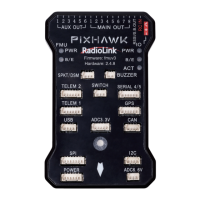Radiolink Electronic Ltd
www.radiolink.com
(3) Move the ch7/ch8 switch into the LOW position at any time to abandon the autotuning and return to the
origin PIDs.
(4) Make sure that you do not have any trim set on your transmitter or the autotune may not get the signal
that the sticks are centered.
6. When the tune completes the copter will change back to the original PID gains.
7. Put the ch7/ch8 switch into the LOW position then back to the HIGH position to test the tuned PID gains.
8. Put the ch7/ch8 switch into the LOW position to fly using the original PID gains.
9. If you are happy with the autotuned PID gains, leave the ch7/ch8 switch in the HIGH position, land and
disarm to save the PIDs permanently.
If you DO NOT like the new PIDS, switch ch7/ch8 LOW to return to the original PIDs. The gains will not be
saved when you disarm.
If you find after performing an AutoTune that the vehicle feels overly twitchy when flying Stabilize, AltHold or
PosHold (but ok in more autonomous modes like Loiter, RTL, Auto) try reducing the RC_FEEL parameter to
0.25. This smooths out the pilot’s input. Alternatively try reducing the AUTOTUNE_AGGR parameter (it should
always be in the range 0.05 to 0.10) and try again.
If the vehicle feels sloppy after the AutoTune, try increasing the AUTOTUNE_AGGR parameter as high as
0.10 and attempt the autotune again.
All of the parameters of PIXHAWK can setup in Mission Planner, please do not change the parameters
during the flight.
Function button for Full Parameter List/Tree introduction:
Load from file: load the files with the parameters have setup already.
Save to file: save the file with the parameters to your computer.
Write Params: write the parameters that have modified to PIXHAWK.

